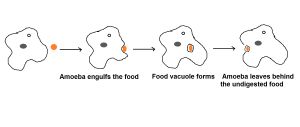NCERT Class 7 Chapter 2 Nutrition in Animals Exercise solution
1. Fill in the blanks:
(a) The main steps of nutrition in humans are __________, __________, __________, _________ and __________.
(b) The largest gland in the human body is __________.
(c) The stomach releases hydrochloric acid and ___________ juices which act on food.
(d) The inner wall of the small intestine has many finger-like outgrowths called _________.
(e) Amoeba digests its food in the ____________ .
Answer: a. Ingestion, Digestion, Absorption, Assimilation, and Egestion.
b. Liver c. Gastric juices d. Villi e. Food vacuole.
2. Mark ‘T’ if the statement is true and ‘F’ if it is false:
(a) Digestion of starch starts in the stomach.
(b) The tongue helps in mixing food with saliva.
(c) The gall bladder temporarily stores bile.
(d) The ruminants bring back swallowed grass into their mouth and chew it for some time.
Answer: a is false, b, c, and d, are true.
Explanation: Digestion of the starch starts in the mouth where Salivary amylase breaks starch into maltose; a smaller carbohydrate.
Our teeth break food into smaller particle. Here tongue helps in mixing the food particles with saliva.
The gall bladder is a small pouch-like organ beneath the liver. It temporarily stores the bile juice.
Cattles are also called ruminants. They have a rumen part in the stomach. Cattles first swallow the grass. Cellulose in the grass is digested in the rumen and then brought back to the mouth for chewing.
3. Tick mark the correct answer in each of the following:
(a) Fat is completely digested in the
(i) stomach (ii) mouth (iii) small intestine (iv) large intestine
(b) Water from the undigested food is absorbed mainly in the
(i) stomach (ii) food pipe (iii) small intestine (iv) large intestine
Answer: a. Small intestine b. Large intestine.
Explanation: Pancreas secretes pancreatic Juice into the small intestine. Pancreatic juice contains lipase enzyme which breaks fats into smaller fatty acid. Intestinal villi absorb these digested fats.
The small intestine absorbs all the nutrient present in the food. Undigested food now goes to the large intestine. Large intestine now absorbs water and mineral from the undigested food.
4. Match the items of Column I with those given in Column II:
Food components: Product(s) of digestion
Answer:
Carbohydrates: Sugar
Fats: Fatty acids and glycerol
Proteins: Amino acids
5. What are villi? What are their location and function?
Villi are the finger-like projections present in the small intestine. A large number of blood vessels richly supplies villi. Villi increase the surface area for the absorption of nutrients by the body.
6. Where is the bile produced? Which component of the food does it help to digest?
The liver secretes bile juice and stores it in the gall bladder. During the meal, gall bladder releases the bile juice into the small intestine. Bile juice acts on the fats and breaks them into smaller fat globules.
7. Name the type of carbohydrate that can be digested by ruminants but not by humans. Give the reason also.
Cellulose cannot be digested by human but cattle digest it. Cattles have rumen in their stomach. The rumen contains microorganisms which break cellulose into maltose. Humans do not have rumen in their stomach. As a result, we cannot digest cellulose.
8. Why do we get instant energy from glucose?
When we take food material. It goes into various stages where food particles are broken into smaller particles and then converted into simpler carbohydrates like glucose and fructose. Glucose is already a simple carbohydrate. When we take it, it undergoes direct absorption and thus gives instant energy.
9. Which part of the digestive canal is involved in:
(i) absorption of food ________________.
(ii) chewing of food ________________.
(iii) killing of bacteria ________________.
(iv) complete digestion of food ________________.
(v) formation of faeces ________________.
Answer: (i) The small intestine (ii) Mouth (iii) Stomach (v) The large intestine.
10. Write one similarity and one difference between nutrition in amoeba and human beings.
The digestive system in amoeba

Amoeba is a unicellular organism without any shape. When it comes in contact with food, it changes own shape and forms a vacuole (vacuole means an empty space) around the food. In the food vacuole, it secretes digestive enzymes and breaks the food particle into simple substances. Once digestion is over it absorbs the nutrition from the food and move away. During this process vacuole with undigested particles are left behind.
Human beings have well-defined chambers for food breakdown, digestion, absorption, and elimination.
Similarity: Both amoeba and humans have heterotrophic mode of nutrition. They follow the same pattern. viz. ingestion, digestion, absorption and elimination.
Differences:
There is no well-developed organ in case of amoeba. Food does not move in case of amoeba.
11. Match the items of Column I with suitable items in Column II
Answer:
Column I: Column II
(a) Salivary gland: Saliva secretion.
(b) Stomach: Acid Release.
(c) Liver: Bile juice secretion.
(d) Rectum: Storage of undigested food.
(e) Small intestine: Digestion is completed.
(f ) Large intestine: Absorption of water.
12. Label Fig. 2.11 of the digestive system.
13. Can we survive only on raw, leafy vegetables/grass? Discuss.
Leafy vegetables like spinach contain indigestible fibres. Cooking vegetables turn undigestible components into digestible forms, which are easy to digest. There are examples of vegetable like pumpkin, papaya, cauliflower, cabbage, turnip, carrots which contain only digestible elements and dietary fibres. But leaves of the most plant are indigestible. Grass contains indigestible fibres as well as cellulose. Cellulose does not breakdown even on cooking. So they are simply undigestible in all cases. Eating such food items will create indigestion and flatulence. So, we can say that we cannot survive only on leafy vegetables and grass only.
See also: NCERT Class 7 Chapter 2 Nutrition in Animals Paheli Boojho Answer.
NCERT Class 7 Chapter 1 Nutrition in Plants Exercise Question Solution.